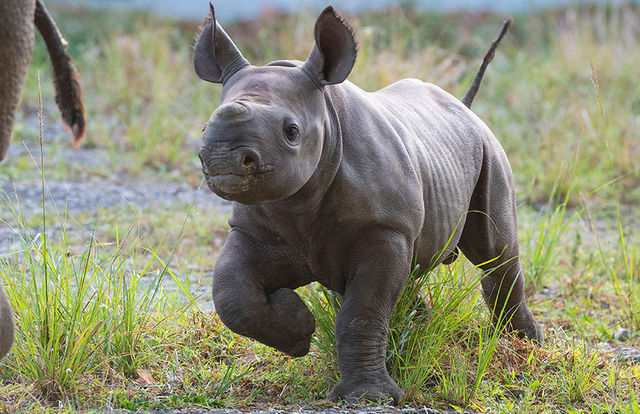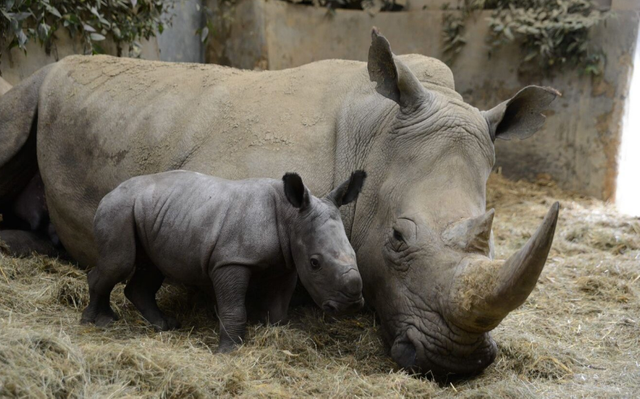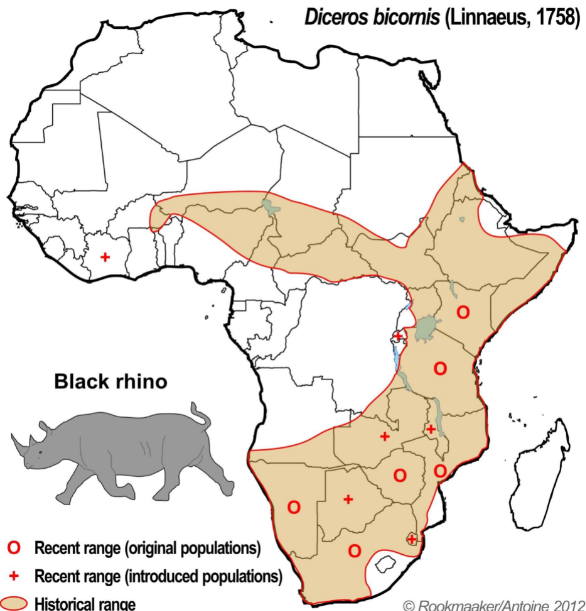Black Rhino
Facts
STATUS: Critically Endangered
POPULATION: Around 5,500
SCIENTIFIC NAME: Diceros bicornis
HEIGHT: 5.2 feet
WEIGHT: 1,760 -3,080 pounds
HABITATS: Semi-Desert Savannah, Woodlands, Forests, Wetlands

The lesser of the two African rhino species is the black rhino. The hooked upper lip of white rhinos distinguishes them from black rhinos. This sets them apart from white rhinos, which have a square lip. Black rhinos are browsers, not grazers, and their pointed lip aids in the consumption of leaves from bushes and trees. They have two horns and a third, smaller posterior horn on rare occasions.
Black rhino populations dropped considerably in the twentieth century due to European hunters and settlers. Between 1960 and 1995, the number of black rhinos fell by 98 percent, to less than 2,500. The species has made a remarkable recovery from the brink of extinction since then. Black rhino numbers have risen from a record low 20 years ago to roughly 5,600 today, thanks to continuous conservation efforts across Africa. However, the black rhino remains severely endangered, and much work remains to get the population up to even a fraction of what it once was—and to keep it there. Wildlife crime, including as rhino poaching and black-market rhino horn trafficking, continues to afflict the species and jeopardize its recovery.

Why They Matter
Rhinos are one of the oldest animal species, almost living fossils. Rhinos play a vital role in their environments, and in countries like Namibia, ecotourism is a major source of revenue. The protection of black rhinos results in the creation of extensive conservation areas. Many other animals, including elephants, benefit from this.
Illegal Wildlife Trade
Poaching is the deadliest of all the dangers to black rhinos. Because black rhinos have two horns, they are a lucrative target for the illegal rhino horn trade. A wave of rhino horn poaching swept across Kenya and Tanzania, then continued south through Zambia's Luangwa Valley to the Zambezi River and into Zimbabwe. In Africa, political unrest and warfare have impeded rhino conservation efforts, particularly in Angola, Rwanda, Somalia, and Sudan. Poverty has worsened dangers such as rhino horn trade and increased poaching as a result of this circumstance.
Today, black rhinos are critically endangered due to increased demand for rhino horn from Asian consumers, mainly in Vietnam and China, who utilize it in traditional medicine. A new spike in rhino poaching in South Africa threatens to undo our conservation gains, with 1,215 rhinos poached in 2014. Poaching rates are gradually declining—594 people were poached in 2019—but the practice continues unabated, with numbers staying unsustainable.

Population Density, Disease, and Inbreeding
In some areas, high population density reduces breeding rates and raises the risk of disease transmission. Inbreeding can have genetic consequences in smaller, isolated groups.